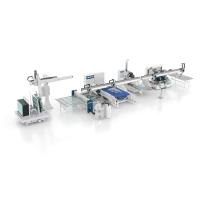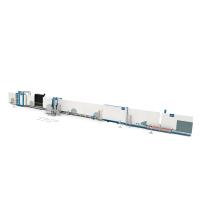
Date: 5 August 2021
The key objectives are clearly improved organic growth and profitability, based on Glaston’s own strategic initiatives and the expected market growth.
Glaston’s addressable glass processing equipment market is expected to grow by more than 5% annually, on average, during the strategy period, and Glaston’s ambition is to clearly exceed this market growth. Strategic must-win development initiatives securing net sales growth and improved profitability have been identified in all Glaston’s business areas and the services business. These initiatives are supported by Group-wide cornerstone initiatives that target improved commercial and operational excellence.
Glaston’s core technologies and lifecycle solutions continue to be at the center of its strategy and Glaston aims to take market share in all its business areas. As the frontrunner in its industry, Glaston plans to increase its investments in innovation and development. Glaston is also continuing its commitment to leading the industry’s digital transformation. Profitability improvement is supported by net sales growth, an optimal product offering, as well as productivity improvements.
Along with its strategy, Glaston has set a new vision, which is to ‘lead the global glass processing industry forward with innovative technologies and lifecycle solutions’. The company’s purpose continues to be ‘build a better tomorrow through safer, smarter and more energy-efficient glass solutions’.
“This strategy builds on our strengths, which are derived from the combination of Bystronic glass and Glaston. We are focusing on fully utilizing the unique opportunity to leverage our wide range of core glass processing technologies, good customer relationships, experienced people with vast know-how, industry-leading services and a large installed base. Strong global megatrends and clearly growing markets, as well as our business area specific and company-wide initiatives, are driving the growth and give us the confidence to set ambitious financial targets”, says Anders Dahlblom, President and CEO of Glaston Corporation.
“Glaston is aiming to take its sustainability ambition to the next level by adding new non-financial targets. These highlight the sustainable nature of our business and the strategic importance of our ESG commitment. I look forward to embarking on this strategic journey together with a fully committed Glaston team”, Dahlblom continues.
Financial targets
Glaston’s new financial targets for the strategy period 2021–2025 are:
- Annual average net sales growth (CAGR) clearly exceeding the addressable equipment market growth of more than 5% (1
- Comparable operating margin (EBITA) of 10% at the end of the strategy period (2
- Comparable return on capital employed (ROCE) of 16% at the end of the strategy period (3
As glass processing technologies continue to be a fragmented industry, Glaston is maintaining an interest in participating in industry consolidation.
SUSTAINABILITY AS A STRATEGIC FOCUS AREA
As the innovative frontrunner in its industry, Glaston’s ambition is to continue being the leader in developing the industry towards a more sustainable future. The majority of Glaston’s business is targeted at the architectural customer segment in which the company’s products provide key technologies for improving energy efficiency and the safety of buildings.
In its own operations, Glaston is committed to providing a safe and good workplace for its employees, being a responsible partner to its customers, utilizing resources efficiently, and reducing the environmental impact of its production processes. Also, as the demand for more energy-efficient and environmentally sustainable glass solutions is growing strongly, Glaston is continuing to develop its product portfolio to meet this demand.
New non-financial targets:
Addressing the company’s focus on sustainability, in addition to its financial targets, Glaston has set new non-financial strategic targets:
- Customer satisfaction score (Net Promoter Score, NPS) above 40
- Group-wide safety target measured as zero lost time accidents (LTA)
- Employee Engagement target above 75 (out of 100)
- Glaston’s CO2 emissions (Scope 1 + 2)(4 in relation to net sales down by 50% from the 2020 level. In 2020, greenhouse gas emissions were 2,777 tons of CO2 with net sales of EUR 170.1 million.
BUSINESS AREA FOCUS ON GROWTH
Glaston will capture growth through its core technologies and lifecycle solutions from the following customer segments: architecture, automotive, display and solar, as well as three regions: the Americas, APAC and EMEA. China is a common focus area throughout Glaston, as it holds the single largest growth potential for all customer segments and Glaston’s business areas.
The following strategic must-win initiatives have been identified:
- Insulating Glass will capitalize on its most advanced and automated technology offering on the market by strengthening and broadening its presence in all main customer segments and regions, particularly in North America and APAC. The move towards carbon neutrality in Europe is already driving growth strongly within the EMEA. The increased focus on reducing the energy consumption of buildings is also expected to boost demand in other regions in the coming years.
- Heat Treatment will continue its systematic development work for increasing the level of automation towards a fully automated tempering line and modularity of products, while broadening the offering. Emphasis is also being placed on optimizing for cost efficiency and quality by, for example, further developing installation processes for an excellent customer experience. Glaston also sees attractive opportunities in solar panel glass processing technologies, in which demand is being driven by the shift to renewable energy.
- Automotive & Display will focus on automotive and selected display applications, as well as commercializing the most comprehensive product portfolio in the industry. Glaston will also continue to develop automotive heat treatment products to complement its market-leading pre-processing products for an integrated offering.
- Services aims to grow in all business areas throughout its product portfolio: spare parts, field services and upgrades, with increased focus on new upgrade development, particularly in the Insulating Glass and Automotive & Display businesses. Other focus areas include improved service accessibility, fast and easy spare parts ordering, as well as further development of the preventive maintenance and remote support concepts. Digitalization, access to data and Artificial Intelligence (AI) capabilities will continue to be important building blocks in creating new service models.
GLASTON CORNERSTONE INITIATIVES
Implementation of the business area-specific initiatives will be supported by improvements in commercial and operational excellence through five Group-wide cornerstone initiatives:
- Innovate with customers to win focuses on strengthening Glaston’s technology leadership (incl. digitalization) by seamless integration of customer understanding, and joint and faster innovation and development work.
- Lead digital transformation includes building the tools and infrastructure across all Glaston operations to lead the industry’s digital transformation.
- Empowering Glaston people to thrive is essential to building the desired company culture. Leadership development and the leveraging of common leadership principles will play a key role in implementing the strategy and embedding it into everyday working life.
- Elevate sustainability and continuous improvement will enable long-term success by building a stronger culture of continuous improvement and systematically progressing the sustainability agenda.
- Master global sourcing and manufacturing will enable operational efficiency and growth through more harmonized sourcing and manufacturing processes.
Glaston’s revised strategy is created in order to achieve clearly improved organic growth and profitability. The roadmap for 2021–2025 builds on Glaston’s business area specific strategic initiatives. The successful execution of the strategy is supported by strong leadership and Group-wide cornerstone projects.
Glaston Corporation
Board of Directors
1) Glaston estimate, in euros. Glaston’s addressable equipment market is expected to grow on average by more than 5% annually during 2021–2025. The growth rate of the addressable equipment market is expected to exceed that of the global flat glass market, which is expected to grow 3–4 % annually in 2021−2025, according to Grand View Research, 2021.
Glaston’s product portfolio is targeting those end-use areas of flat glass that are growing faster than average (e.g. insulating glass). The addressable equipment market also includes the customers’ replacement investments after the operational life of machinery. During 2021−2025, replacement investments will be further derived from productivity gains, especially through automation, as well as technology and regulatory changes. Also, inflation explains part of the difference between volume-based and euro-based market estimates.
2) Calculation of key ratio: Comparable EBITA: Operating result before amortization, impairment of intangible assets and purchase price allocation +/- items affecting comparability
3) Calculation of key ratio: Comparable return on capital employed, % (Comparable ROCE): (Profit/loss before taxes + amortization of purchase price allocations +/- items affecting comparability + financial expenses x 100)/Equity + interest-bearing liabilities, average as of 1 January and end of the reporting period
4) Scope 1 emissions: direct greenhouse gas (GHG) emissions that occur from sources that are controlled or owned by Glaston (e.g., emissions associated with fuel oil, diesel and natural gas).
Scope 2 emissions: indirect GHG emissions associated with the purchase of electricity, heat, and cooling.
 600450
600450













Add new comment